How to define a lead, MQL, SQL and opportunity
Getting lead and sales qualification right, enables your marketing and sales team to get on the same page and close more deals.
- Blog
It's not the 90s. Marketing has changed. Interruptive, annoying, salesy marketing doesn't work anymore.
Let’s be honest, no one likes ads popping up in the middle of their favourite TV show, movie or YouTube video. Or how about those cold calls from private numbers at 5:35pm on a Friday night. Or an inbox full of spammy emails starting with “Dear Sir.”
The above examples are marketing tactics that used to work. Let’s call it Marketing 1.0. It can also be referred to as traditional, outbound, push or mass marketing.
Enter inbound marketing. Originally conceived by Brian Halligan and Dharmesh Shah from HubSpot in 2006, inbound marketing is Marketing 2.0 and it’s how the best companies and marketers are driving traffic, leads and sales.
If you’re not on the inbound marketing bandwagon yet, you need to be.
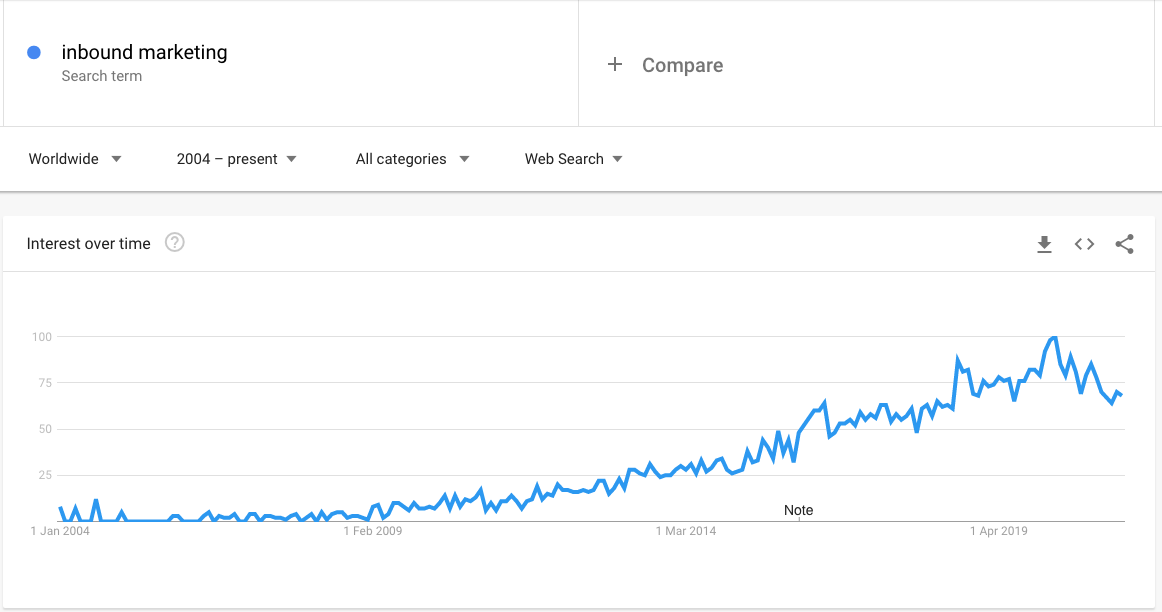
According to HubSpot, inbound marketing is described this way.
“Inbound marketing is a business methodology that attracts customers by creating valuable content and experiences tailored to them. While outbound marketing interrupts your audience with content they don’t always want, inbound marketing forms connections they are looking for and solves problems they already have.”
Inbound marketing is centred around content, which is why for many marketers, inbound marketing and content marketing can be used interchangeably.
Content drives the inbound methodology and provides the fuel for your blog posts, eBooks, social media, SEO and so on.
A couple of years ago, HubSpot famously stated that the “funnel is dead.”
The images below from HubSpot and Ahrefs illustrate the standard sales/marketing funnel and the key stages.
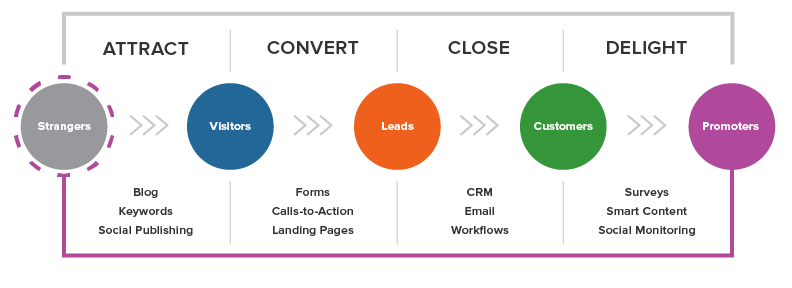
Our friends at Ahrefs, illustrate it using the industry standard awareness, interest, consideration and conversion stages.
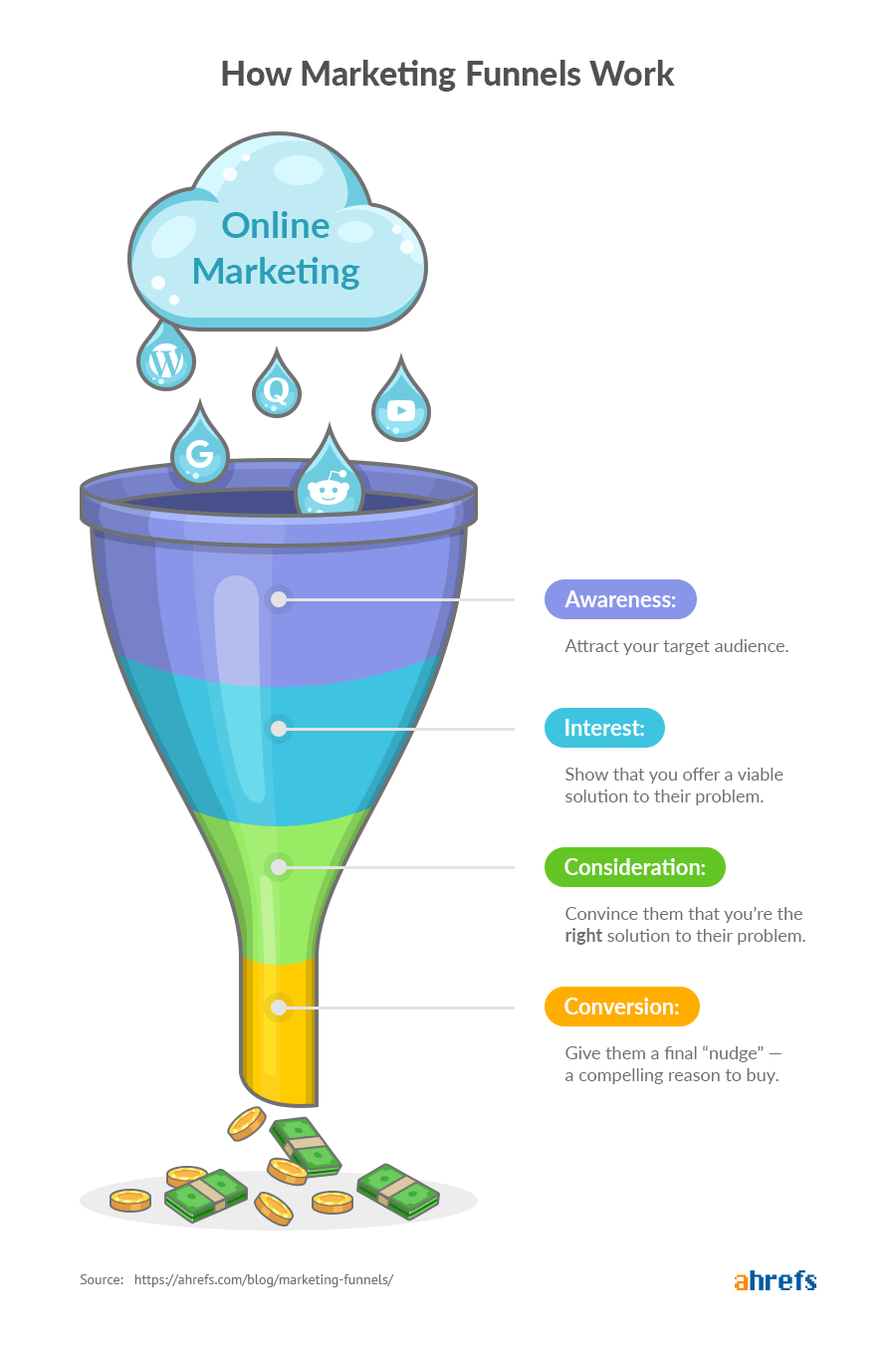
HubSpot then pitched the “flywheel,” which they felt better reflected the intrinsic value of the inbound methodology.
The funnel vs flywheel debate is highly contentious, but HubSpot’s flywheel does keep the basic funnel stages as before — attract, convert, close and delight — but simplifies it and recognises the momentum of a flywheel that can drive business growth.
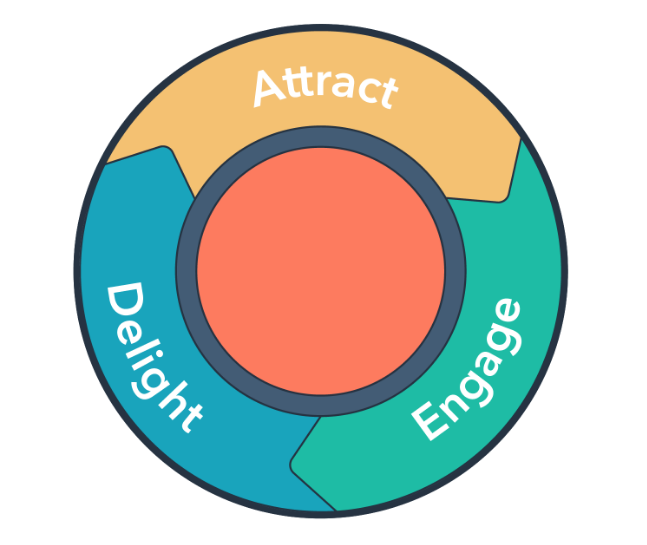
Here are the three key parts of the inbound methodology:
1. Attract: drawing in the right people with valuable content and conversations that establish you as a trusted advisor with whom they want to engage.
2. Engage: presenting insights and solutions that align with their pain points and goals so they are more likely to buy from you.
3. Delight: providing help and support to empower your customers to find success with their purchase.
When this inbound flywheel is working well, strangers become prospects, prospects become customers and customers become promoters. This creates a self-sustaining loop that generates momentum.
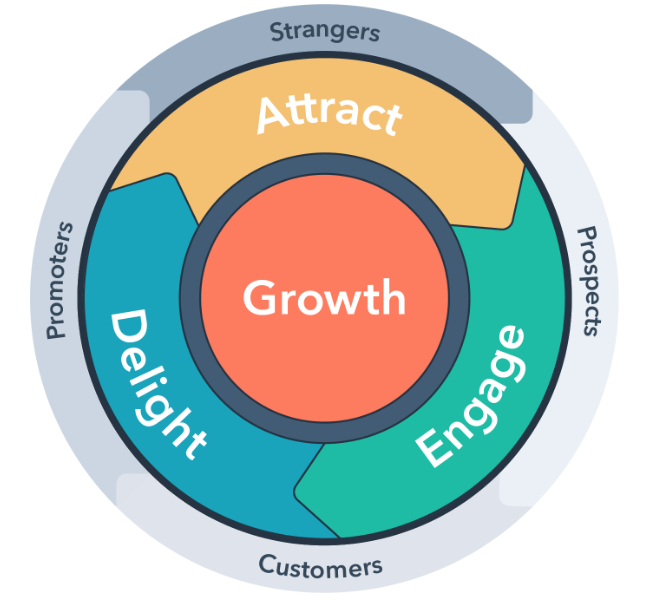
To make the inbound flywheel spin faster, it needs more strangers, prospects, customers and promoters — or the acquisition and retention of customers.
Friction makes the inbound flywheel spin slower. Low quality marketing that doesn’t attract the right prospects, overly pushy sales and poor customer service/success all contribute to a bloated funnel.
Using HubSpot’s attract, engage and delight stages, here’s a breakdown of how you can rollout inbound marketing in your business.
Inbound starts by attracting your target audience and buyer personas. It’s focused on driving traffic to your website or landing pages.
It starts with creating high-quality content that adds value to strangers and prospects. Think blog posts, eBooks, whitepapers, webinars, infographics, videos, tools and social media. The best content here focuses on your customer’s problems, challenges and frustrations and offers a solution.
Search engine optimisation (SEO) is a key part of this attract phase. SEO is a great way to drive organic search traffic to your website. Optimising your content for the search engine results page (SERP) and identifying specific keywords and phrases that are important for your business, allows you to be found.
Think about a time that you’ve had a problem that you weren’t sure how to solve. If you’re anything like me, you probably jumped onto Google to research some potential solutions. Chances are you stumbled across a blog, an infographic or another piece of content that not only answered your question, but that also offered help in an interesting and relevant way. You may have been so impressed with what you found that you followed the publisher on social media and subscribed to their newsletter.
Over time, after seeing their content across your socials or in your inbox, you begin to trust their insights and you value their point of view. So when you come across one of their products or services, that baseline level of trust that already exists, meaning you’re more likely to move from a prospect to a customer.
Paid advertising also plays a role here — just a different role to how it has been used in traditional marketing. Like SEO, paid ads can help to drive traffic to your website and landing pages. But instead of interruptive, salesy messaging, paid ads are used instead to amplify your amazing content and get it out to the world.
High-value content offers or “lead magnets” — like eBooks, whitepapers or guides — work particularly well here. They add value and they consistently outperform outbound/traditional marketing in terms of cost-per-click (CPC), cost-per-lead (CPL) and overall ROI.
Once you’ve attracted the right prospects to your website or landing page, you want to convert them into leads and engaging with them across multiple channels — ideally moving (and nurturing) them from leads to customers.
This includes having a conversation with website visitors over live chat, chatbots, Facebook Messenger or other messaging apps. It also includes reaching out to them via email, SMS, phone and social media.
Conversion tools like calls-to-action (CTAs), forms, live chat, landing pages and exit popups are important at this stage to capture some information on your prospects so that you can start the relationship.
Here’s an example of Assignar using CTAs on their website to drive leads.
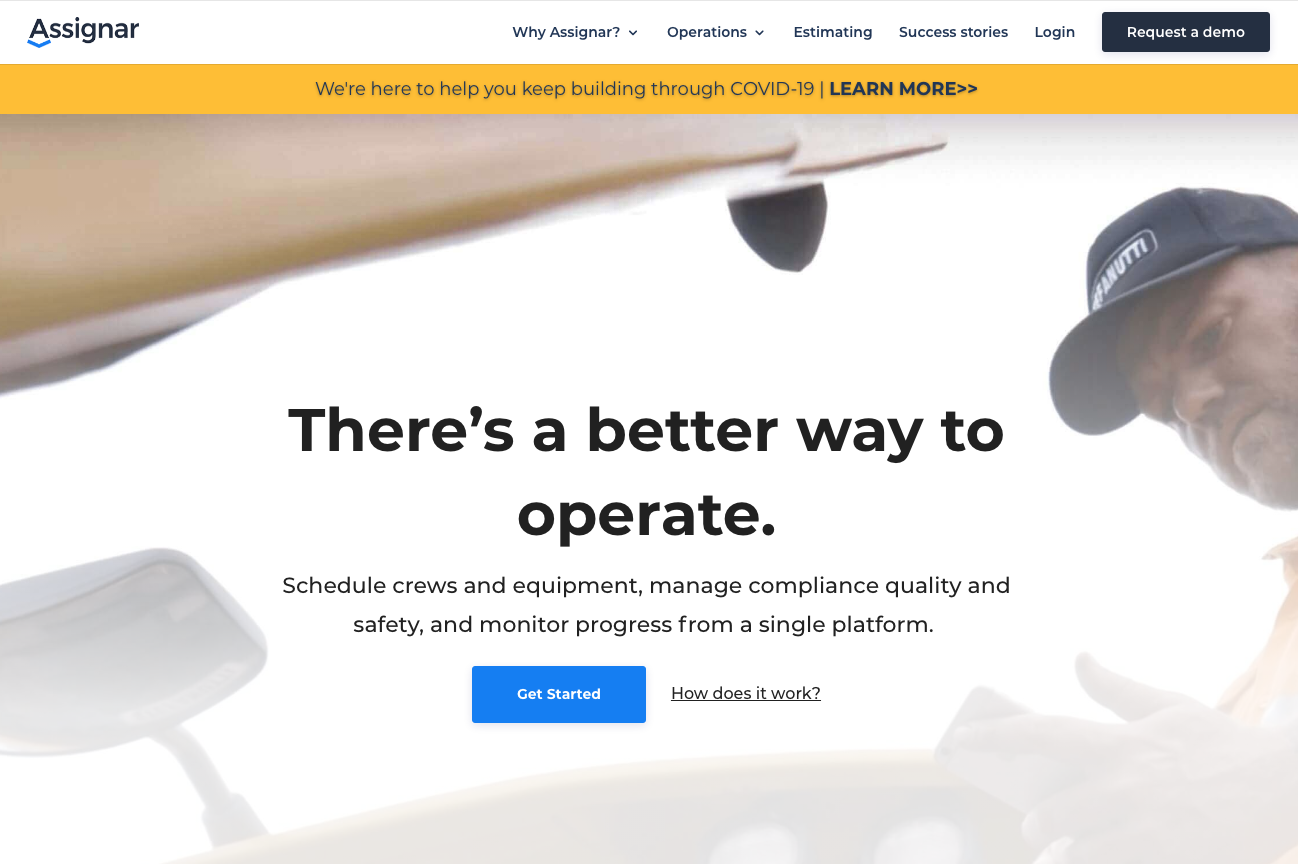
An integrated CRM and website content management system (CMS) allows you to do this engage stage well. They allow you to personalise the experience for your prospects and customers. You’ll be able to deliver valuable content to the right person at the right time and this will build loyalty, customers and promoters.
The delight phase is all about customer retention. It’s about ensuring that your customers are happy, satisfied and supported when they become a customer. Happy customers mean more promoters, more referrals and even more customers — a spinning flywheel.
Leveraging surveys and social media listening allows you to provide feedback to your customers, answer questions and show that you hear and care about them.
Email marketing and marketing automation can really drive this delight stage.
According to HubSpot, outbound marketing can be defined this way.
“Outbound marketing is a traditional method of marketing seeking to push messaging out to potential customers. Outbound marketing includes activities such as trade shows, seminar series and cold calling. It is costly and the ROI is much lower than inbound marketing.”
Like I mentioned in the intro, outbound marketing is push marketing that includes cold calling, door-to-door sales, email blasts to purchased lists, print advertising, junk mail, spam, trade shows and salesy/interruptive advertising. Outbound marketing is when a marketer reaches out to people to see if they're interested in a product or service in a way that suits the marketer, not the prospect.
The problem with traditional marketing is that it’s almost impossible to measure ROI. Mass marketing is costly and risky. It’s like throwing spaghetti against the wall and hoping some of it will stick. The problem is that you don’t know which part of the spaghetti stuck!
Inbound marketing brings great returns over the long term and can deliver website traffic month after month, even with no paid ads.
Using Ahrefs as an example, their blog ranks for 173,000 organic keywords and brings an estimated 364,000 monthly visitors. If they were trying to get that same amount of traffic via paid ads, they’d be spending an estimated $976k per month — nowhere near the amount they spend on creating content (on good authority).

Just because someone is aware of your product or service, it doesn’t necessarily mean that they will choose it. Companies that invest in inbound marketing and provide a consistent stream of high-value content builds trust, credibility and loyalty.
Taking a page out of Marcus Sheridan’s book They Ask You Answer, inbound marketing allows you to become the most trusted voice in your industry when you listen to your customers and answer their questions.
It helps to keep your prospects and customers engaged and informed, which builds retention.
Marketing isn’t just about brand awareness, website traffic and leads — it’s about generating the right traffic and qualified leads.
Because inbound marketing pulls your buyer persona to your business and answers their questions at a time and place convenient to them, you’re more likely to get warm leads coming through.
It’s true that inbound marketing really is Marketing 2.0 and it will continue to grow across all industries, including B2B and B2C.
The days of disruptive, salesy, loud mass marketing are (thankfully) over. Instead, use inbound marketing to generate leads, acquire customers and importantly retain customers for longer.
Inbound marketing is the long game but it’s the better game and it all starts with high-quality content.
Learn more about B2B marketing and HubSpot.
Nathan is the CEO and Founder of Content Chemistry, a digital marketing agency and a HubSpot Platinum Solutions Partner. He has over 15 years' marketing experience in Australia and Europe, working both on the client-side and as an agency. He's passionate about content/inbound marketing, SEO and sales funnels. And yes he's been told that he looks like Roger Federer.